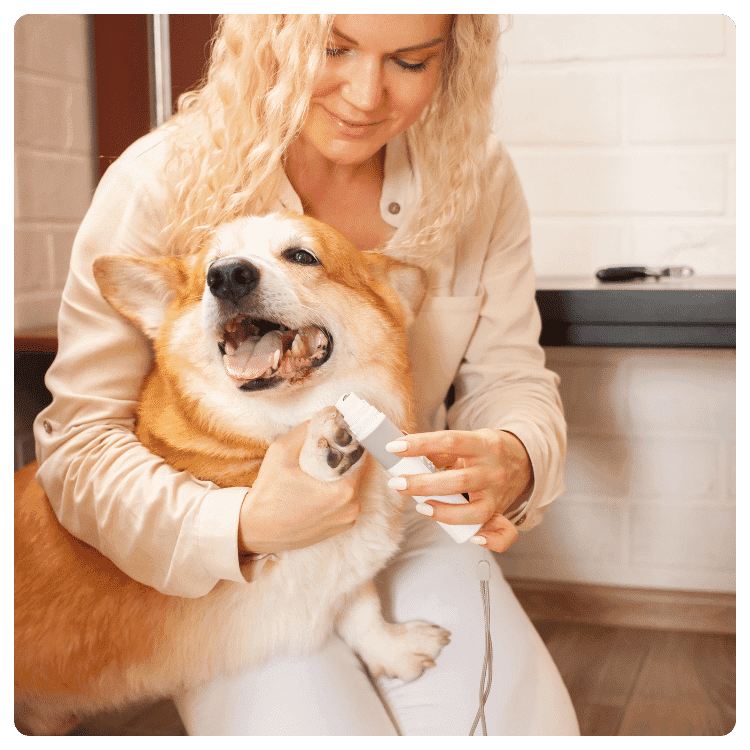
STORY AT-A-GLANCE
- If your dog is obsessively licking her paws and in between her toes, or licking or chewing at her rear end or inner thighs, chances are she’s allergic to something in the environment
- An excellent way to reduce your dog’s itchiness and paw licking is to do daily foot soaks during the warmer months of the year to rinse away all the allergens and other contaminants that collect on her feet
- When it comes to obsessive licking, some dogs lick everything but themselves (e.g., floors, carpets, walls, furniture) and may have a disorder called ELS — excessive licking of surfaces
- Many dogs with ELS actually have a GI disorder that is triggering the excessive licking; these dogs require a customized treatment protocol to address and resolve the underlying GI condition
Editor’s Note: This article is a reprint. It was originally published May 18, 2018.
Healthy dogs groom themselves, but unlike cats, they don’t spend much time at it. So if you notice your dog doing an excessive amount of licking, it’s important to figure out why, because something is probably making her itchy and miserable.
There are a variety of reasons dogs lick themselves, but by far the most common is environmental allergies. If your dog is licking her paws and in between her toes, or she’s licking or chewing at her rear end or inner thighs, it’s likely she’s having an allergic reaction to something in the environment that’s making her itchy.
The reason so many dogs lick their paws is because during the spring and summer months, those often sweaty little Swiffers are constantly picking up allergens and chemicals in the environment, including ragweed, grasses, dust mites, pollens, molds, fertilizers, pesticides, herbicides and more. When you consider how often most dogs go outside, it’s clear that a wide range of potential irritants can build up fast on their feet.
So that’s the bad news, but the good news is that about 50% of most dogs’ seasonal foot licking and chewing can be alleviated by simply removing those irritants from their paws each time they come in from outdoors, or at least daily.
Soak Your Dog’s Feet to Relieve Itching and Licking
The secret to success in removing allergens from a dog’s feet is that they have to be soaked or rinsed. Simply wiping them off with a damp cloth won’t give your pet nearly the relief he’ll feel with a foot soak. There are many ways to do foot soaks, so you may need to experiment to find the method that works best for you and your dog.
For example, if you have a large- or medium-sized dog, you can use a bucket and soak one foot at a time. If your dog is small, you can use your kitchen or bathroom sink. What’s important is to soak those paws at the end of any day during which your dog has been in contact with allergens, lawn chemicals or anything in the environment with the potential to irritate his feet.
My favorite solution for foot soaks is povidone iodine (brand name, Betadine), which is an organic iodine solution. It’s safe, nontoxic, antifungal, antibacterial and anti-yeast, and you can buy it in the pharmacy section of almost any store. Add just enough water in your foot soak to cover your dog’s feet, and enough iodine to turn the water to the color of iced tea.
Alternatively, you can also use white vinegar (sold by the gallon in the grocery store) diluted 50/50 with water. Some people leave a pail of the solution on their deck, in the garage or at the front or back door and make a fresh batch every few days. I don’t recommend going more than two or three days using the same foot soak solution.
To receive the full benefit of the foot soak, your dog needs to stand in the solution for two to five minutes. You don’t have to do anything during this time except help him keep his paws in the footbath — the solution will do all the work. Pet your dog as he soaks, talk or sing or read to him, and praise him for being such a good dog. If he seems anxious, offer a few treats.
If he’s truly fearful of the water, instead of putting him in a sink or tub, make a mini-soak in a small container and let him soak one foot at a time. This will take longer, obviously, but you may be able to graduate to all four paws in the water simultaneously after he gets comfortable with one foot at a time.
The key to successful foot soaks is to keep the paws submerged in the solution for long enough to thoroughly wash away any type of yeast that might be growing, as well as mild bacterial infections, allergens and other contaminants.
Also remember that you don’t have to use much water or povidone iodine — just enough to fully cover your dog’s foot pads with a solution the color of iced tea. This conserves both water and iodine, and if your dog is nervous, it will also reduce his anxiety because there’s not much water involved. There’s no need to rinse the solution off your dog’s feet after the soak. Just pat his paws dry and you’re done.
If you’re doing the foot soaks as I describe at least once a day, but your dog is continuing to lick, bite or chew at himself, he’s probably allergic to something else he’s being exposed to — perhaps ingredients in his diet, or something in his indoor environment. You can learn more about food sensitivities here, and additional environmental allergies here.
What if My Dog Is Obsessively Licking Everything BUT Herself?
Dogs that obsessively lick things may have a disorder called excessive licking of surfaces (ELS), which involves the relentless, repetitive licking of floors, carpets, walls, furniture, their owner’s legs, hands or arms, and even their own lips. It does not refer to self-licking, which is usually caused by itchy, irritated, or inflamed skin, hot spots and/or acral lick dermatitis.
Excessive licking behavior may seem harmless, which is why many dog parents just try to ignore it. However, if your dog swallows enough hair or fibers from the objects he’s licking, it could potentially result in a very serious intestinal blockage requiring surgery.
Some concerned dog owners ask their veterinarian about the behavior, and are often told it’s an obsessive-compulsive disorder. However, many of us in the holistic and integrative veterinary community have known for years that animals who “air lick” or obsessively lick floors, sofas, carpets, etc., almost always have gastrointestinal (GI) issues.
A small 2012 study of dogs with ELS showed that 74% (14 of 19) had some type of GI disease, including eosinophilic and/or lymphoplasmacytic infiltration of the GI tract, delayed gastric emptying, irritable bowel syndrome, chronic pancreatitis, gastric foreign body and giardiasis.1
Dogs With ELS Need a Customized Treatment Protocol
When I treat dogs with ELS, I always try to resolve the problem without resorting to the use of drugs. An exception might be in the case of an established, identified infection (e.g., giardiasis) requiring antiparasitics or antibiotics because the infection was not responsive to natural alternatives.
In addressing the diet, I always steer clear of processed pet food, including commercial elimination diets. Most “veterinary diets” contain poor-quality, rendered, feed-grade ingredients as well as synthetic nutrients to make up for the depletion that occurs during the substantial manufacturing process.
Instead, I go with a customized anti-inflammatory diet of fresh, whole, organic and non-GMO foods. Each diet must be tailored to the animal’s specific GI disorder(s) and symptoms, so I recommend working with an integrative or holistic veterinary nutritionist to create the perfect diet for your dog.
In addition, healing modalities such as acupuncture and chiropractic can be very helpful in treating GI disorders. For example, many dogs with excessive licking behavior have hiatal hernias that can be managed with chiropractic care.
If you’re concerned your dog may have ELS and/or a GI condition, I recommend making an appointment with your integrative or holistic veterinarian for a checkup, including all appropriate diagnostic tests and a thorough GI evaluation. Once you’ve ruled a GI disorder in or out, together you can decide the best approach to treat your dog’s specific situation.






